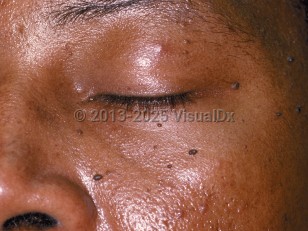Dermatosis papulosa nigra in Adult
Alerts and Notices
Important News & Links
Synopsis

Dermatosis papulosa nigra (DPN) are benign epidermal growths similar to seborrheic keratoses (SK). These lesions are typically asymptomatic and are most frequently seen on the cheeks. They are much more common in Black individuals and people of Asian descent. It is less frequently described in the White population, where SKs are more common. A 2007 study in Senegal of 30 patients with DPN found a genetic predisposition in 93%.
According to a 2003 study among Afro-Caribbean people, more participants with light phototypes (skin type V or less) had the lowest frequency of involvement. In addition to Black individuals, the condition has also been reported in Filipino, Vietnamese, European, and Mexican individuals.
The onset of DPN is typically during adolescence, and lesions initially look like freckles. Women are affected more often than men. There may be a family history of similar lesions. The number of lesions typically increases with age, peaking in the sixth decade. Up to one-third of Black adults have some of these lesions. Approximately 25% of patients with facial lesions will also have lesions at other body locations such as the neck, chest, and back. DPNs also become larger with age.
DPN is a cosmetic concern only. In contrast to SKs, where rapid onset of numerous lesions can be a cutaneous sign of internal malignancy, multiple DPNs are not related to any systemic disease or syndrome.
According to a 2003 study among Afro-Caribbean people, more participants with light phototypes (skin type V or less) had the lowest frequency of involvement. In addition to Black individuals, the condition has also been reported in Filipino, Vietnamese, European, and Mexican individuals.
The onset of DPN is typically during adolescence, and lesions initially look like freckles. Women are affected more often than men. There may be a family history of similar lesions. The number of lesions typically increases with age, peaking in the sixth decade. Up to one-third of Black adults have some of these lesions. Approximately 25% of patients with facial lesions will also have lesions at other body locations such as the neck, chest, and back. DPNs also become larger with age.
DPN is a cosmetic concern only. In contrast to SKs, where rapid onset of numerous lesions can be a cutaneous sign of internal malignancy, multiple DPNs are not related to any systemic disease or syndrome.
Codes
ICD10CM:
L82.1 – Other seborrheic keratosis
SNOMEDCT:
254669003 – Dermatosis papulosa nigra
L82.1 – Other seborrheic keratosis
SNOMEDCT:
254669003 – Dermatosis papulosa nigra
Look For
Subscription Required
Diagnostic Pearls
Subscription Required
Differential Diagnosis & Pitfalls

To perform a comparison, select diagnoses from the classic differential
Subscription Required
Best Tests
Subscription Required
Management Pearls
Subscription Required
Therapy
Subscription Required
References
Subscription Required
Last Reviewed:03/07/2021
Last Updated:01/13/2022
Last Updated:01/13/2022
 Patient Information for Dermatosis papulosa nigra in Adult
Patient Information for Dermatosis papulosa nigra in Adult
Premium Feature
VisualDx Patient Handouts
Available in the Elite package
- Improve treatment compliance
- Reduce after-hours questions
- Increase patient engagement and satisfaction
- Written in clear, easy-to-understand language. No confusing jargon.
- Available in English and Spanish
- Print out or email directly to your patient
Upgrade Today

Dermatosis papulosa nigra in Adult

